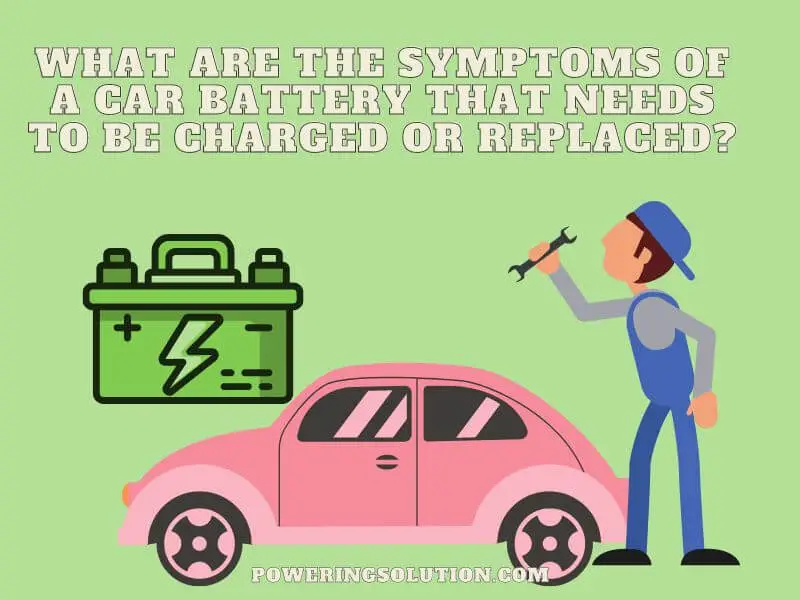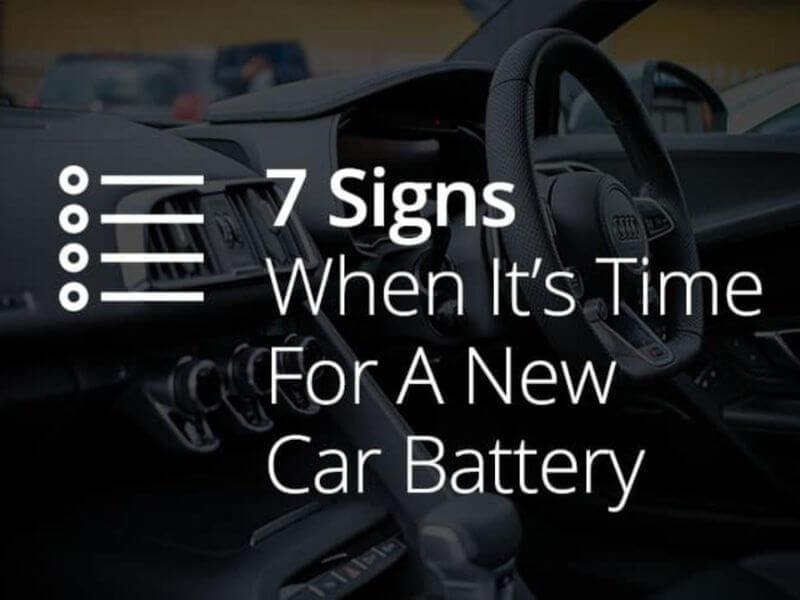If your car battery is more than three years old, it’s a good idea to have it tested annually to see if it needs to be replaced.
There are several ways you can tell if your battery needs to be charged or replaced. If your car won’t start, the battery may be dead and need to be recharged. Another way to tell if the battery is bad is if the headlights are dim when the engine is off. If they’re dim when the engine is running, that means the alternator isn’t charging the battery.
- If your car doesn’t start, it may be because the battery needs to be charged or replaced
- You can check the battery yourself by using a voltmeter to measure its voltage
- A healthy battery should have a voltage of 12
- 6 volts or higher
- If the voltage is below 12
- 6 volts, it indicates that the battery needs to be charged
- You can do this by connecting the battery to a charger and allowing it to charge for several hours
- If the battery still will not hold a charge after being charged, then it likely needs to be replaced
What are the Symptoms of a Car Battery That Needs to Be Charged Or Replaced?

If your car battery is dead, you may experience one or more of the following symptoms:
- Your engine won’t start
- Headlights and/or taillights are dim or flickering
- Dashboard lights are dim or flickering
- Interior lights are dim or flickering
- The power seats are slow to move back or forth
- The audio system sounds weak or distorted
- Your key fob won’t work.
How Do You Know If Your Car Battery is Dying?
If your car battery is dying, there are a few telltale signs:
| Number one | The first and most obvious sign is that the engine won’t start. If you turn the key in the ignition and nothing happens, or if the engine starts but then dies immediately, it’s likely that your battery is dead or close to it. |
| Number two | Another sign that your battery may be dying is dimming headlights. If you notice that your headlights are significantly dimmer than usual, it’s a good indication that your battery is losing power and needs to be replaced. |
| Number three | Finally, if your car seems to be having trouble starting in cold weather, this could also be a sign of a dying battery. So it is always better to warm up your car battery for 30 minutes in cold weather. |
If you suspect that your car battery may be dying, it’s important to have it checked out by a mechanic as soon as possible to avoid being stranded with a dead vehicle. Also, don’t forget to check your solenoid. A bad starter solenoid will drain power from your car.
What are the Signs That Your Car Battery Needs to Be Replaced?

One of the most common signs that your car battery needs to be replaced is when it won’t start your car. If you turn the key and nothing happens, or if your car struggles to start, it’s a good indication that your battery is on its last legs.
Another sign that your battery needs replacing is dim headlights. If you notice that your headlights are significantly dimmer than usual, it means that your battery isn’t providing enough power to run them effectively.
Finally, if your battery is more than three years old, it’s probably time for a replacement, regardless of how it’s performing.
How Often Should You Replace Your Car Battery?
Most car batteries last between three and five years. If your battery is showing signs of age (dim headlights, slow engine crank, clicking sound when starting the car), it’s time to have it tested. Many auto parts stores will test your battery for free.
If your battery fails the test, it’s time to replace it. Depending on the make and model of your car, you may be able to do this yourself. Some cars have easy-access battery compartments under the hood, while others require a bit more work to get to the battery.
If you’re not comfortable doing this yourself, any mechanic or auto shop can replace your battery for you.
What are Some Tips for Prolonging the Life of Your Car Battery?
Assuming you would like tips for prolonging the life of your car battery:
| Keep it clean | A clean battery will last longer than a dirty one. Make sure to keep the terminals free of corrosion. You can do this by cleaning them with a mixture of water and baking soda or with a commercial terminal cleaner. |
| Keep it charged | A fully charged battery will last longer than one that is only partially charged. Try to keep your battery above 12 volts. If it falls below that, it could damage the battery and shorten its lifespan. |
| Don’t overcharge it | Overcharging your battery can damage it and shorten its lifespan. When charging your battery, make sure to follow the manufacturer’s instructions carefully. |
| Avoid extreme temperatures | Both hot and cold temperatures can damage your car battery and shorten its lifespan. If possible, store your car in a garage or other cool, dry place to protect the battery from excessive heat or cold weather conditions. |
Signs of a Bad Car Battery Vs. Alternator
If your car doesn’t start, it may be due to a bad battery or alternator. But how can you tell which one is the problem? Here are some signs to look for:
Bad Battery Signs:
1. The engine cranks slowly when you try to start the car.
2. The headlights are dim or flickering.
3. You hear a clicking noise when you turn the key in the ignition. This can be a sign that your battery terminals are corroded and need to be cleaned.
Alternator Signs
1. The engine starts but then dies shortly after starting.
2. The headlights are very dim or completely dark.
Weak Car Battery Symptoms
If your car battery is on the verge of dying, you may notice one or more of the following symptoms:
| Number one | The engine cranks slowly when you try to start the car |
| Number two | The headlights are dim, or they flicker when you turn them on. |
| Number three | The interior lights are dim, or they don’t come on at all. |
| Number four | The power windows move slowly, or they don’t work at all |
| Number five | The radio doesn’t work, or it has static interference |
At What Percentage Should a Car Battery Be Replaced?
A car battery should be replaced when it reaches 70% of its original capacity. A full replacement is not necessary until the battery reaches 80% of its original capacity, but at this point, the battery will need to be replaced sooner rather than later.
How to Check Car Battery Without Multimeter?
It’s always a good idea to keep a close eye on your car battery. After all, it is the heart of your vehicle, and if it fails, you’re not going anywhere. The best way to do this is with a multimeter.
A multimeter is an essential tool for any car owner. It allows you to check the voltage of your battery without having to open up the hood and hook up jumper cables. Simply connect the positive lead of the multimeter to the positive terminal of your battery and the negative lead to the negative terminal. If everything is working properly, you should see a reading of 12 volts on the display.
If you don’t have a multimeter, there are still some things you can do to check your battery.
One way is to simply listen for any strange noises coming from under the hood. If you hear anything out of the ordinary, it could be an indication that your battery is on its last legs. Another way is to keep an eye on your headlights. If they seem dimmer than usual, that could also be a sign that your battery needs attention.
Of course, the best way to avoid any problems with your car battery is to keep it properly maintained. This means regularly cleaning both terminals and making sure they are free of corrosion. You should also make sure that all connections are tight and free of dirt or debris.
Flat Battery Vs. Dead Battery
A car battery is considered “dead” when it no longer produces enough voltage to start the engine. A flat battery, on the other hand, simply means that the battery has lost its charge and needs to be recharged.
There are a few different ways to tell if your car battery is dead or just flat:
- If you turn the key in the ignition and nothing happens, that’s a pretty good indication that your battery is dead.
- Another way to tell is if your headlights are dim or flickering; this usually means that the battery doesn’t have enough power to fully operate all of the electrical components in your car.
If the battery is just flat, you can try jump-starting it with another vehicle. If the battery is truly dead, however, you’ll need to replace it with a new one.
When to Replace Car Battery Voltage?
When to Replace Car Battery Voltage A car battery is an essential part of a vehicle, providing the electrical current that powers the engine and other accessories. Over time, batteries will degrade and lose their capacity to hold a charge.
When this happens, it’s important to know when to replace the battery to avoid being stranded on the side of the road. There are a few telltale signs that indicate it’s time for a new battery:
Slow Engine
The engine is slow to start or doesn’t start at all. This is often due to low voltage in the battery.
Headlights are Dim
The headlights are dim or flickering. This can be caused by damaged cells in the battery that are no longer able to hold a charge.
Frequent Problems in Starting
The car has been having frequent problems starting. If you find yourself having to jumpstart your car more than once every few months, it’s probably time for a new battery. If you’re unsure whether your car needs a new battery, take it to a mechanic or auto parts store for testing.
They can determine if the problem is with the battery or some other component of the electrical system.
Final Thought
If your car doesn’t start, it could be due to a dead battery. If you’re having trouble starting your car, it’s important to first determine whether the problem lies with the battery or something else in the electrical system.
